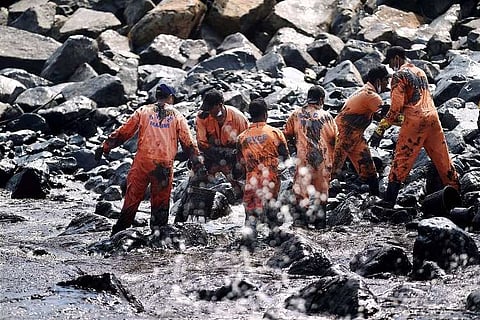

On January 28, this year, at around 4 am, two ships- the inbound vessel MT Dawn Kanchipuram and the outbound vessel MT BW Maple- collided near the Kamarajar port at Ennore.
MT Dawn sustained damages to its heavy fuel tank leading to an oil spill in the sea- the oil sludge deposits would spread over 40 km along the coast in the coming days.
The vessel had 32,000 tonnes of oil when the collision happened.
The first big lie was uttered four days after the spill, when port authorities told The News Minute that only close to 1 tonne of oil had spilled into the sea. However, the Indian Coast Guard had estimated that 20 metric tonnes of oil would have originally leaked from the ship.
Though other government agencies slowly started admitting that the damage was much more than what was projected by the Kamarajar port, the fact remains that port authorities underplayed the extent of the spill.
An affidavit submitted by the Tamil Nadu government to the National Green Tribunal, a copy of which TNM has accessed, states that the Indian Coast Guard reported a recovery of 187 tonnes of oil and sludge, 109 kilo litres (KL) of oil mixed with water and 81.5 tonnes of sludge following the spill.
Another report by the Indian Coast Guard says that "though the slick was estimated to be 02 tons, however post collection of oil sludge, it was observed to be more than 150 tons".
Who bore the brunt?
The Central Pollution Control Board in a notice to the Tamil Nadu Pollution Control Board says that it has been realized that the water was polluted due to the oil spill.
"The Central Pollution Control Board carried out an assessment of sea water quality along Ennore, Kasimedu fishing port, Marina and Besant Nagar beach and found that oil and grease were in the range 1.1 mg/l to 5.2mg/l which is in exceedance to the primary water quality criteria of 0.1 mh/l"
The CPCB also noted that marine aquatic life had been affected and sea water quality had deteriorated.
TN govt report to NGT
The TN government told NGT that there was no spillage of petroleum products, but only heavy fuel oil in the sea.
Most of the oil accumulated near Ramkrishna Nagar Kuppam beach and eventually spread to the coast line between Kasimedu fishing harbor and Tiruvottiyur, Marina beach, Elliot's beach, and the Tiruvanmiyur coastline up to Injambakkam village.
Thousands of people worked to contain and recover the oil spill at various sites including Ernavoor, Chennai Fishing Harbour,Marina beach, Besant Nagar, Kottivakkam, Palavakkam, Neelankarai and Injambakkam beaches.
In Chennai district alone, 3,636 workmen were deployed to clean up beaches and remove oil residues. They removed 30.1 tonnes of oil bearing sediments and sludge from Tondiarpet, Tripicane, Mylapore, Besant Nagar, and Tiruvanmiyur beaches till 4.2.2017.
According to the document, "It was reported that thereafter there was no oil spill deposition observed in coastal stretches of Chennai district".
208 tonnes of oil spillage sludge was removed from Ramakrishna Nagar Kuppam, Ernavoor on 08.02.2017 whereas 23.2 tonnes sludge mixed with sand was collected from Kottivakkam to Injambakkam villages of Kancheepuram District on 02.02.2017.
The government in its affidavit said that just after it got information on the spill, it tried to remove the oil and sludge using rope skimmers, oil skimmers, high pressure pumps and gully suckers.
"Since the oil remnants in the spill had hardened and it got transformed into a slimy sludge due to coagulation, difficulties were encountered in pumping the residues. Hence manual operation had to be resorted for removal of the oily sludge washed onshore and which got deposited on the boulders at Ramakrishna Nagar Kuppam, Ernavoor," it said.